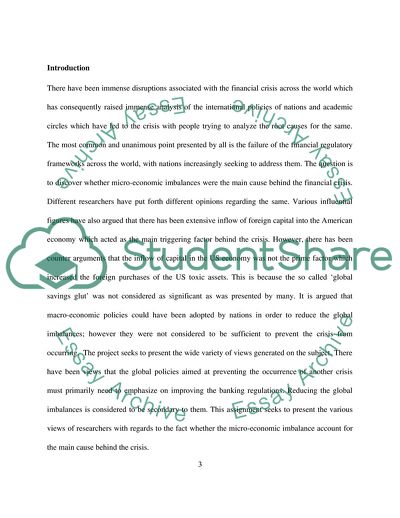Cite this document
(Global macroeconomic imbalances are the cause of the crisis. (RICHARD Essay, n.d.)
Global macroeconomic imbalances are the cause of the crisis. (RICHARD Essay. https://studentshare.org/macro-microeconomics/1764603-global-macroeconomic-imbalances-are-the-cause-of-the-crisis-richard-portes-critically-analyse-this-assessment-you-may-answer-with-reference-to-either-global-macroeconomic-imbalances-and-the-current-global-crisis-or-with-specific-referenc
Global macroeconomic imbalances are the cause of the crisis. (RICHARD Essay. https://studentshare.org/macro-microeconomics/1764603-global-macroeconomic-imbalances-are-the-cause-of-the-crisis-richard-portes-critically-analyse-this-assessment-you-may-answer-with-reference-to-either-global-macroeconomic-imbalances-and-the-current-global-crisis-or-with-specific-referenc
(Global Macroeconomic Imbalances Are the Cause of the Crisis. (RICHARD Essay)
Global Macroeconomic Imbalances Are the Cause of the Crisis. (RICHARD Essay. https://studentshare.org/macro-microeconomics/1764603-global-macroeconomic-imbalances-are-the-cause-of-the-crisis-richard-portes-critically-analyse-this-assessment-you-may-answer-with-reference-to-either-global-macroeconomic-imbalances-and-the-current-global-crisis-or-with-specific-referenc.
Global Macroeconomic Imbalances Are the Cause of the Crisis. (RICHARD Essay. https://studentshare.org/macro-microeconomics/1764603-global-macroeconomic-imbalances-are-the-cause-of-the-crisis-richard-portes-critically-analyse-this-assessment-you-may-answer-with-reference-to-either-global-macroeconomic-imbalances-and-the-current-global-crisis-or-with-specific-referenc.
“Global Macroeconomic Imbalances Are the Cause of the Crisis. (RICHARD Essay”. https://studentshare.org/macro-microeconomics/1764603-global-macroeconomic-imbalances-are-the-cause-of-the-crisis-richard-portes-critically-analyse-this-assessment-you-may-answer-with-reference-to-either-global-macroeconomic-imbalances-and-the-current-global-crisis-or-with-specific-referenc.


